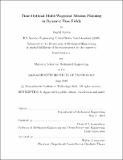Time-optimal multi-waypoint mission planning in dynamic flow fields
Author(s)
Ferris, David, S.M. (David Lee). Massachusetts Institute of Technology
DownloadFull printable version (5.100Mb)
Other Contributors
Massachusetts Institute of Technology. Department of Mechanical Engineering.
Advisor
Pierre F.J. Lermusiaux.
Terms of use
Metadata
Show full item recordAbstract
This thesis demonstrates the use of exact equations to predict time-optimal mission plans for a marine vehicle that visits a number of locations in a given dynamic ocean current field. The missions demonstrated begin and end in the same location and visit a finite number of locations or waypoints in the minimal time; this problem bears close resemblance to that of the classic "traveling salesman," albeit with the added complexity of a continuously changing flow field. The paths, or "legs," between all goal waypoints are generated by numerically solving exact time-optimal path planning level-set differential equations. The equations grow a reachability front from the starting location in all directions. Whenever the front reaches a waypoint, a new reachability front is immediately started from that location. This process continues until one set of reachability fronts has reached all goal waypoints and has returned to the original location. The time-optimal path for the entire mission is then obtained by trajectory backtracking, going through the optimal set of reachability fields in reverse order. Due to the spatial and temporal dynamics, a varying start time results in different paths and durations for each leg and requires all permutations of travel to be calculated. Even though the method is very efficient and the optimal path can be computed serially in real-time for common naval operations, for additional computational speed, a high-performance computing cluster was used to solve the level set calculations in parallel. This method is first applied to several hypothetical missions. The method and distributed computational solver are then validated for naval applications using an operational multi-resolution ocean modeling system of real-world current fields for the complex Philippines Archipelago region. Because the method calculates the global optimum, it serves two purposes. It can be used in its present form to plan multi-waypoint missions offline in conjunction with a predictive ocean current modeling system, or it can be used as a litmus test for approximate future solutions to the traveling salesman problem in dynamic flow fields.
Description
Thesis: Nav. E., Massachusetts Institute of Technology, Department of Mechanical Engineering, 2018. Thesis: S.M., Massachusetts Institute of Technology, Department of Mechanical Engineering, 2018. This electronic version was submitted by the student author. The certified thesis is available in the Institute Archives and Special Collections. Cataloged from student-submitted PDF version of thesis. Includes bibliographical references (pages 43-49).
Date issued
2018Department
Massachusetts Institute of Technology. Department of Mechanical EngineeringPublisher
Massachusetts Institute of Technology
Keywords
Mechanical Engineering.